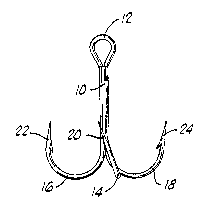Some of the information on this Web page has been provided by external sources. The Government of Canada is not responsible for the accuracy, reliability or currency of the information supplied by external sources. Users wishing to rely upon this information should consult directly with the source of the information. Content provided by external sources is not subject to official languages, privacy and accessibility requirements.
Any discrepancies in the text and image of the Claims and Abstract are due to differing posting times. Text of the Claims and Abstract are posted:
| (12) Patent: | (11) CA 2069385 |
|---|---|
| (54) English Title: | TREBLE HOOK |
| (54) French Title: | HAMECON TRIPLE |
| Status: | Expired and beyond the Period of Reversal |
| (51) International Patent Classification (IPC): |
|
|---|---|
| (72) Inventors : |
|
| (73) Owners : |
|
| (71) Applicants : |
|
| (74) Agent: | SMART & BIGGAR LP |
| (74) Associate agent: | |
| (45) Issued: | 1995-12-26 |
| (22) Filed Date: | 1992-05-25 |
| (41) Open to Public Inspection: | 1993-11-26 |
| Examination requested: | 1992-05-25 |
| Availability of licence: | N/A |
| Dedicated to the Public: | N/A |
| (25) Language of filing: | English |
| Patent Cooperation Treaty (PCT): | No |
|---|
| (30) Application Priority Data: | None |
|---|
A treble fishing hook includes an elongated shank which has
a first end and a second end. An eye is secured to the first
end of the shank. Three barb-carrying bight portions are
secured to the second end of the shank with the three bight
portions being equally spaced about the axis of the shank and
separated by an angle of about 120. Each of the bight portions
is bent outwardly from the shank so as to lie in a plane which
extends at an angle of from about 14 to about 20 to the axis
of the shank. A barb is carried on each of the bight portions,
and each barb is angularly displaced out of the plane of the
bight portion.
Note: Claims are shown in the official language in which they were submitted.
Note: Descriptions are shown in the official language in which they were submitted.

2024-08-01:As part of the Next Generation Patents (NGP) transition, the Canadian Patents Database (CPD) now contains a more detailed Event History, which replicates the Event Log of our new back-office solution.
Please note that "Inactive:" events refers to events no longer in use in our new back-office solution.
For a clearer understanding of the status of the application/patent presented on this page, the site Disclaimer , as well as the definitions for Patent , Event History , Maintenance Fee and Payment History should be consulted.
| Description | Date |
|---|---|
| Time Limit for Reversal Expired | 2004-05-25 |
| Letter Sent | 2003-05-26 |
| Inactive: Late MF processed | 2001-06-28 |
| Letter Sent | 2001-05-25 |
| Grant by Issuance | 1995-12-26 |
| Application Published (Open to Public Inspection) | 1993-11-26 |
| All Requirements for Examination Determined Compliant | 1992-05-25 |
| Request for Examination Requirements Determined Compliant | 1992-05-25 |
There is no abandonment history.
| Fee Type | Anniversary Year | Due Date | Paid Date |
|---|---|---|---|
| MF (patent, 6th anniv.) - standard | 1998-05-25 | 1998-03-24 | |
| MF (patent, 7th anniv.) - standard | 1999-05-25 | 1999-05-06 | |
| MF (patent, 8th anniv.) - standard | 2000-05-25 | 2000-05-23 | |
| Reversal of deemed expiry | 2001-05-25 | 2001-06-28 | |
| MF (patent, 9th anniv.) - standard | 2001-05-25 | 2001-06-28 | |
| MF (patent, 10th anniv.) - standard | 2002-05-27 | 2002-05-14 |
Note: Records showing the ownership history in alphabetical order.
| Current Owners on Record |
|---|
| EBSCO INDUSTRIES, INC. |
| Past Owners on Record |
|---|
| JIM GOWING |